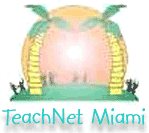

|
How It Works: This unit takes student on an educational musical journey through time merging reading, writing, music and technology. The combination of technology and hands-on activities motivates students to improve reading, writing, and music skills as well as increasing their enthusiasm for learning about music and its changes over the decades. Students have the opportunity to learn about different types of music from Baroque to Gospel, composers from Beethoven to Run D.M.C, and styles from swing to hip hop. All learning styles are involved: the auditory learner hears the music, the visual learner views pictures of instruments and composers, the tactile learner creates listening tapes and/or CDs and the kinesthetic learner taps out rhythms of songs. Standards: Estimated Class Periods To Complete: 8 Software Materials Used: This unit requires that students have access to the Internet, a word processing program such as Microsoft Word, The Student Writing Center or AppleWorks; a multimedia program such as PowerPoint, Kid Pix, or HyperStudio; and various musical books, magazines, and listening selections Keywords: classical, romantic, baroque, hip hop, rap, reggae, gospel, jazz, opera, folk, disco, tempo, orchestra, dynamics, swing, style, strings, brass, woodwind, percussion, composer, conductor Students: This unit is suitable for most ages of students. Due to the universal appeal of music this unit could be adapted to be used in most classrooms. Students need to have an understanding of how to navigate around on the Internet as well as have a basic understanding of word processing. Overall: Students improve reading, writing and technology skills as they listen to, evaluate, and classify many kinds of music. Music is the universal language therefore all students with all levels of language comprehension can participate and achieve success. Tips: Tapes and CDs of musical selections can be checked out from a local library at no cost. Look for sales at music stores to stock up on music selections. Book mark top music sites. Ear phone use is excellent as it permits students the opportunity to listen to music while at the computer and in listening centers. Ask school music teachers for pictures of families of instruments and famous composers. |
About the Teacher: Kim Norkin has been teaching for thirteen years and currently teaches at Bel-Aire Elementary School in Miami Florida. She presently teaches third grade. However, she has taught second grade as well as fourth grade. She has just completed her Masters Degree in Reading and is the School Site Coordinator for the Citibank Family Tech Program. Subjects: Language Arts and Music Grade Levels: 3 through 10
|
What do you think of my
project? I'd really like to hear your opinion -
Click here for a very brief survey.